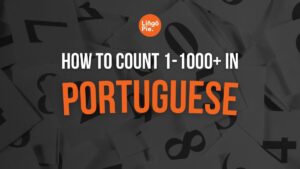
Learning how to count in Portuguese is one of the most practical and essential skills for anyone starting their language journey. Whether you’re traveling to Portugal, Brazil, or any other Portuguese-speaking country, numbers are everywhere—on menus, street signs, prices, and even in casual conversations. The good news is that Portuguese numbers are straightforward to learn, and with a little practice, you’ll be counting like a pro in no time. In this article, we’ll guide you through the basics of Portuguese numbers, from 0 to 1,000 and beyond, with tips to help you master them quickly.
1. Portuguese Numbers 0-10
Let’s start with the basics. These are the foundation of all numbers in Portuguese:
- 0 – Zero (ZEH-roh)
- 1 – Um (OOM) / Uma (OO-mah)
- 2 – Dois (DOYSS) / Duas (DOO-ahs)
- 3 – Três (TREHSS)
- 4 – Quatro (KWA-troh)
- 5 – Cinco (SEEN-koh)
- 6 – Seis (SAYSS)
- 7 – Sete (SEH-chee)
- 8 – Oito (OY-toh)
- 9 – Nove (NOH-vee)
- 10 – Dez (DEHSS)
Notice that the numbers 1 and 2 have masculine (um, dois) and feminine (uma, duas) forms. This depends on the gender of the noun they are describing. For example:
- Um carro (One car – masculine)
- Uma casa (One house – feminine)
2. Numbers 11-20
The numbers from 11 to 20 are unique and need to be memorized, as they don’t follow a predictable pattern:
- 11 – Onze (ON-zee)
- 12 – Doze (DOH-zee)
- 13 – Treze (TREH-zee)
- 14 – Catorze (kah-TOR-zee)
- 15 – Quinze (KEEN-zee)
- 16 – Dezesseis (deh-zee-SAYSS)
- 17 – Dezessete (deh-zee-SEH-chee)
- 18 – Dezoito (deh-ZOY-toh)
- 19 – Dezenove (deh-zeh-NOH-vee)
- 20 – Vinte (VEEN-chee)
3. Numbers 21-99
Once you’ve mastered the numbers up to 20, the rest becomes much easier. Numbers from 21 to 99 follow a simple pattern: combine the tens (20, 30, 40, etc.) with the units (1-9), using the word e (and) in between. For example:
- 21 – Vinte e um (VEEN-chee ee OOM)
- 32 – Trinta e dois (TREEN-tah ee DOYSS)
- 45 – Quarenta e cinco (kwah-REN-tah ee SEEN-koh)
- 58 – Cinquenta e oito (seen-KWEN-tah ee OY-toh)
- 99 – Noventa e nove (noh-VEN-tah ee NOH-vee)
Here are the tens in Portuguese:
- 20 – Vinte (VEEN-chee)
- 30 – Trinta (TREEN-tah)
- 40 – Quarenta (kwah-REN-tah)
- 50 – Cinquenta (seen-KWEN-tah)
- 60 – Sessenta (seh-SEN-tah)
- 70 – Setenta (seh-TEN-tah)
- 80 – Oitenta (oy-TEN-tah)
- 90 – Noventa (noh-VEN-tah)
4. Numbers 100-1,000
Larger numbers in Portuguese are also straightforward. Here’s how to count in hundreds:
- 100 – Cem (SENG)
- 200 – Duzentos (doo-ZEN-tohs)
- 300 – Trezentos (treh-ZEN-tohs)
- 400 – Quatrocentos (kwah-troh-SEN-tohs)
- 500 – Quinhentos (keen-YEN-tohs)
- 600 – Seiscentos (say-SEN-tohs)
- 700 – Setecentos (seh-cheh-SEN-tohs)
- 800 – Oitocentos (oy-toh-SEN-tohs)
- 900 – Novecentos (noh-veh-SEN-tohs)
- 1,000 – Mil (MEEL)
To form numbers like 101, 202, or 350, simply combine the hundreds with the smaller numbers, using e (and) when necessary:
- 101 – Cento e um (SEN-toh ee OOM)
- 202 – Duzentos e dois (doo-ZEN-tohs ee DOYSS)
- 350 – Trezentos e cinquenta (treh-ZEN-tohs ee seen-KWEN-tah)
5. Thousands and Beyond
Once you’ve mastered the hundreds, moving into the thousands is easy. The word for thousand is mil, and it works just like in English:
- 1,000 – Mil (MEEL)
- 2,000 – Dois mil (DOYSS MEEL)
- 10,000 – Dez mil (DEHSS MEEL)
- 100,000 – Cem mil (SENG MEEL)
- 1,000,000 – Um milhão (OOM meel-YOWN)
For numbers like 1,234, you simply combine the components:
- 1,234 – Mil duzentos e trinta e quatro (MEEL doo-ZEN-tohs ee TREEN-tah ee KWA-troh)
6. Practical Uses of Numbers
Numbers are incredibly useful in everyday situations. Here are some examples of how you might use them while traveling:
- Shopping:
- Quanto custa? (How much does it cost?)
- Custa vinte e cinco reais. (It costs 25 reais.)
- Time and Dates:
- Que horas são? (What time is it?)
- São três horas. (It’s three o’clock.)
- Transportation:
- O ônibus número quinze. (The bus number 15.)
- O trem sai às oito e meia. (The train leaves at 8:30.)
7. Tips for Learning Portuguese Numbers
- Practice Daily: Repetition is key. Practice counting out loud every day.
- Use Real-Life Scenarios: Practice numbers while shopping, reading prices, or checking the time.
- Listen to Native Speakers: Watch videos, listen to podcasts, or use language apps to hear how numbers are pronounced.
- Write Them Down: Write numbers in Portuguese to reinforce spelling and structure.
Final Thoughts
Mastering Portuguese numbers is an essential step in your language-learning journey. Whether you’re ordering food, asking for directions, or shopping, numbers are a part of everyday life. By learning the basics and practicing regularly, you’ll be able to count confidently in Portuguese in no time. Remember, the key is consistency—so start practicing today and watch your skills grow!


